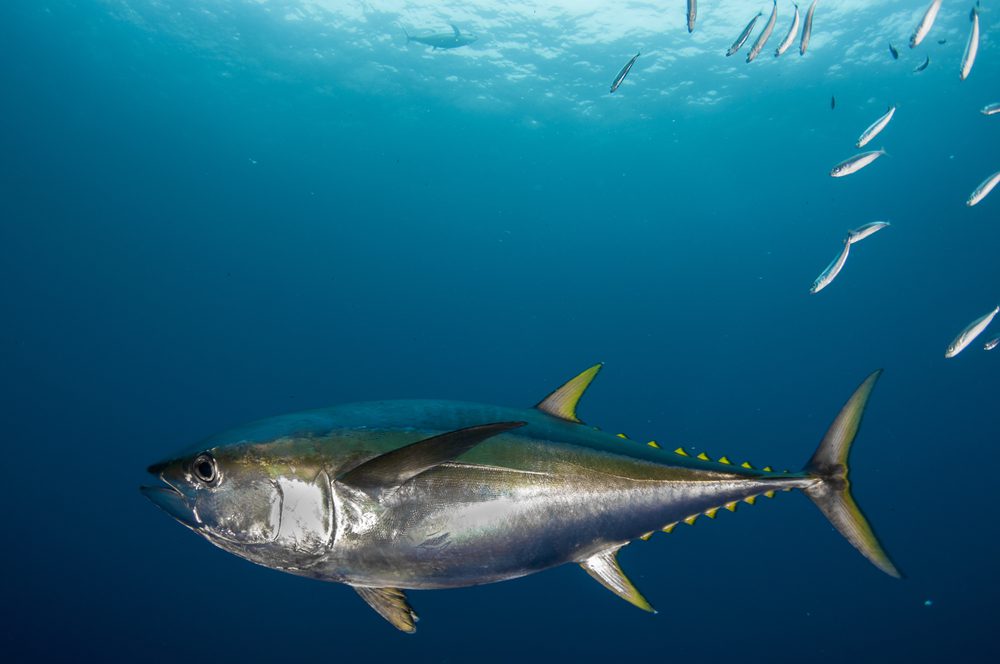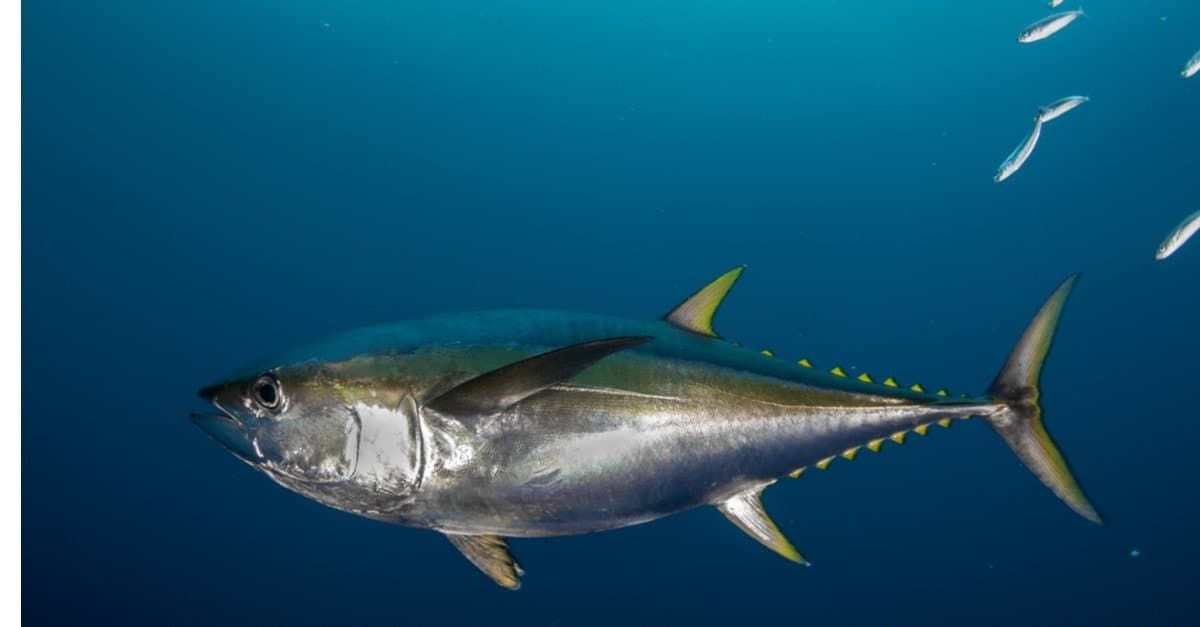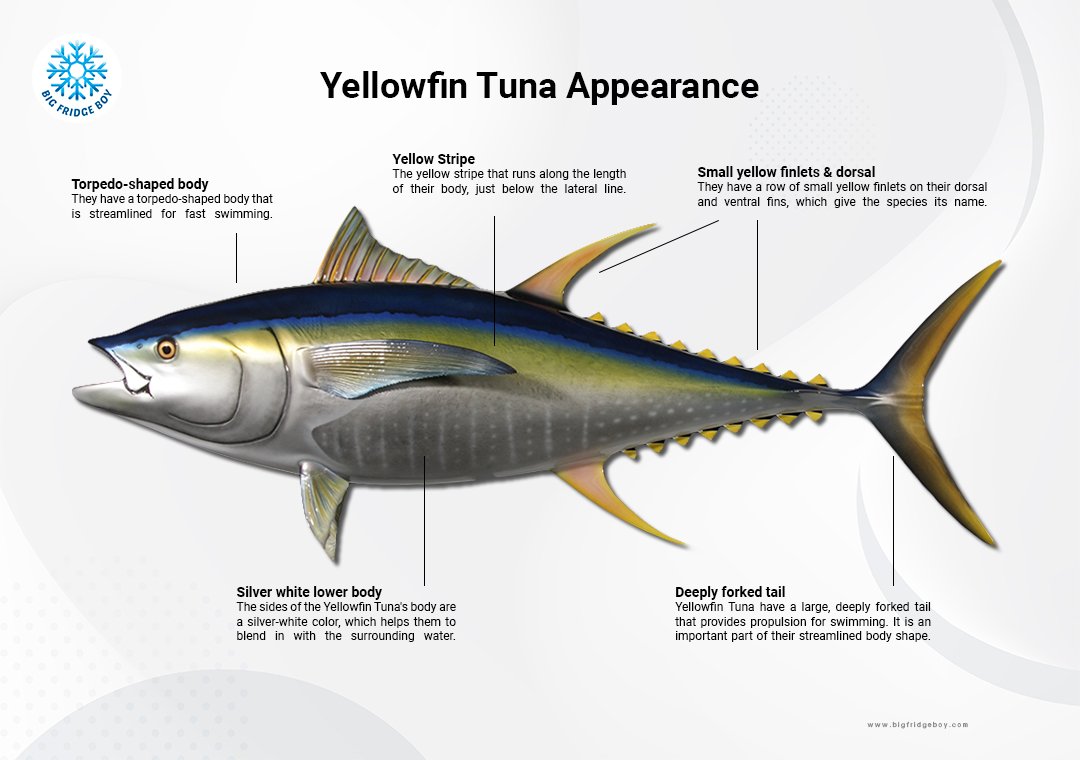Introduction

Yellowfin and Yellowtail Tuna are two popular types of fish that are highly sought after for their delicious taste and versatility in cooking. While both varieties belong to the tuna family, they have distinct characteristics that set them apart. In this article, we will delve into the world of Yellowfin and Yellowtail Tuna, exploring their unique flavors, culinary uses, and nutritional benefits. Whether you’re a seafood lover or a culinary enthusiast looking to expand your knowledge, this article will provide you with a comprehensive understanding of the differences between Yellowfin and Yellowtail Tuna. So, let’s dive in and unravel the secrets behind these exceptional tuna varieties.
Overview Of Yellowfin And Yellowtail Tuna
Yellowfin and Yellowtail Tuna are two highly prized species of tuna that are beloved by seafood enthusiasts and culinary gourmands alike. Yellowfin Tuna, also known as Ahi Tuna, is renowned for its firm texture and mild flavor. It is often favored for its vibrant red color, which makes it visually appealing in various dishes. On the other hand, Yellowtail Tuna, also referred to as Hamachi, has a buttery mouthfeel and a slightly sweeter taste. Its pale pink flesh is tender and melts in your mouth. Both varieties are versatile in cooking and offer a range of culinary possibilities.
Yellowfin Tuna
Yellowfin Tuna, also known as Ahi Tuna, is a highly sought-after species known for its firm texture and mild flavor. Its meat is characterized by a vibrant red color, making it visually appealing in various dishes. Yellowfin Tuna is versatile in cooking and can be enjoyed raw as sashimi or in sushi rolls, or cooked through methods such as grilling, searing, or baking. Its flavor pairs well with a variety of seasonings and sauces, allowing for endless culinary creativity. Whether enjoyed in a salad, sandwich, or as a main course, Yellowfin Tuna is a delightful addition to any seafood lover’s menu.
Yellowfin Tuna: Characteristics And Flavor Profile

Yellowfin Tuna, also known as Ahi Tuna, boasts several distinct characteristics that make it a prized fish among seafood enthusiasts. This species typically has a torpedo-shaped body with vibrant yellow dorsal and anal fins. One of Yellowfin Tuna’s notable features is its firm texture, which allows it to hold up well in different cooking methods. When it comes to flavor, Yellowfin Tuna offers a mild and slightly sweet taste that is often described as meaty and buttery. Its meat is known for its rich, red color and is highly sought after for its sashimi-grade quality. The flavor of Yellowfin Tuna pairs well with a variety of seasonings and sauces, making it a versatile and delicious choice for culinary creations. Whether enjoyed raw, cooked, or grilled, Yellowfin Tuna delivers a flavorful and satisfying seafood experience.
Yellowfin Tuna: Culinary Uses And Recipes
Yellowfin Tuna is a highly versatile fish that can be prepared in a variety of delicious ways. Its firm texture and mild, slightly sweet flavor make it a popular choice for grilling, searing, or baking. Yellowfin Tuna is often used in dishes such as tuna steaks, tacos, salads, and poke bowls. It can also be enjoyed raw as sashimi or in sushi rolls. One popular recipe is seared Yellowfin Tuna with a soy ginger glaze, served with steamed vegetables and rice. Another option is to marinate the tuna in a citrus-based marinade and grill it for a smoky and tangy flavor. With its versatility and delicious taste, Yellowfin Tuna is a go-to option for seafood lovers.
Yellowtail Tuna
Yellowtail Tuna, also known as Hamachi in Japan, has a distinct appearance and taste that sets it apart from Yellowfin Tuna. This species has a slender body shape with a silver belly and a yellowish-green back, giving it its name. In terms of flavor, Yellowtail Tuna has a buttery and rich taste that is often described as mild yet savory. Its firm texture makes it perfect for grilling or searing, and it can be enjoyed in a variety of dishes such as sushi, sashimi, or even in cooked preparations like teriyaki. Yellowtail Tuna offers a unique and delicious seafood experience for those who appreciate its distinct flavor profile.
Yellowtail Tuna: Appearance And Taste

Yellowtail Tuna, also known as Hamachi in Japan, has a distinct appearance and taste that sets it apart from Yellowfin Tuna. This species has a slender body shape with a silver belly and a yellowish-green back, giving it its name. In terms of flavor, Yellowtail Tuna has a buttery and rich taste that is often described as mild yet savory. Its firm texture makes it perfect for grilling or searing, and it can be enjoyed in a variety of dishes such as sushi, sashimi, or even in cooked preparations like teriyaki. Yellowtail Tuna offers a unique and delicious seafood experience for those who appreciate its distinct flavor profile.
Yellowtail Tuna: Differences From Yellowfin And Culinary Applications
Yellowtail Tuna stands out from Yellowfin Tuna not only in appearance but also in taste and culinary applications. While Yellowfin Tuna has a stronger flavor, Yellowtail Tuna offers a milder and more delicate taste. Additionally, Yellowtail Tuna has a firmer texture, making it ideal for grilling and searing. Its buttery and rich flavor profile lends itself well to sushi, sashimi, and cooked preparations like teriyaki. The distinct qualities of Yellowtail Tuna make it a popular choice for those who prefer a milder and more tender tuna experience. Whether enjoyed raw or cooked, Yellowtail Tuna offers a delectable seafood option.
Nutritional Comparison
When it comes to the nutritional aspect, both Yellowfin and Yellowtail Tuna offer a wide array of health benefits. They are both excellent sources of lean protein, omega-3 fatty acids, and essential vitamins and minerals. However, there are some slight differences in their nutritional profiles.
Yellowfin Tuna tends to have slightly higher levels of protein and fat, while Yellowtail Tuna is slightly lower in fat content. Yellowtail Tuna is also known for its higher vitamin and mineral content, such as vitamin B12 and selenium.
Overall, both varieties of tuna are nutritious choices packed with essential nutrients that can support a healthy diet. Adding either Yellowfin or Yellowtail Tuna to your meals can provide a boost of protein and omega-3s while adding delicious flavors to your dishes.
Yellowfin Vs. Yellowtail Tuna: Nutritional Values

When it comes to the nutritional aspect, both Yellowfin and Yellowtail Tuna offer a wide array of health benefits. They are both excellent sources of lean protein, omega-3 fatty acids, and essential vitamins and minerals. However, there are some slight differences in their nutritional profiles.
Yellowfin Tuna tends to have slightly higher levels of protein and fat, while Yellowtail Tuna is slightly lower in fat content. Yellowtail Tuna is also known for its higher vitamin and mineral content, such as vitamin B12 and selenium.
Overall, both varieties of tuna are nutritious choices packed with essential nutrients that can support a healthy diet. Adding either Yellowfin or Yellowtail Tuna to your meals can provide a boost of protein and omega-3s while adding delicious flavors to your dishes.
Health Benefits Of Yellowfin And Yellowtail Tuna
Both Yellowfin and Yellowtail Tuna offer numerous health benefits. They are rich sources of lean protein, which is essential for muscle growth and repair. These tuna varieties also contain omega-3 fatty acids, which can help reduce inflammation and promote heart health. Additionally, they provide important vitamins and minerals, such as vitamin D, vitamin B12, and selenium. These nutrients support immune function, promote healthy skin, and contribute to overall well-being. Including Yellowfin and Yellowtail Tuna in your diet can provide a delicious and nutritious way to meet your body’s nutritional needs.
Sustainability And Fishing Practices
Sustainability is a key concern when it comes to fishing practices for both Yellowfin and Yellowtail Tuna. Overfishing can deplete tuna populations and disrupt the balance of marine ecosystems. To promote sustainability, several measures have been implemented. These include enforcing strict fishing quotas, implementing fishing gear modifications to reduce bycatch, and employing sustainable fishing methods such as pole and line or handline fishing. Additionally, organizations like the Marine Stewardship Council (MSC) work to certify Tuna fisheries that meet rigorous sustainability standards. By supporting sustainable fishing practices, we can ensure the continued availability of Yellowfin and Yellowtail Tuna for future generations to enjoy.
Sustainability Practices In Yellowfin And Yellowtail Tuna Fishing

To ensure the long-term sustainability of Yellowfin and Yellowtail Tuna fishing, several practices have been implemented. Fishing quotas are strictly enforced to prevent overfishing and maintain healthy tuna populations. Modifications to fishing gear, such as using circle hooks and employing Fish Aggregating Devices (FADs) with biodegradable materials, help reduce bycatch and protect other marine species. Sustainable fishing methods, such as pole and line or handline fishing, are also encouraged to minimize negative impacts on the environment. Certification programs like the Marine Stewardship Council (MSC) provide a way to identify Tuna fisheries that meet rigorous sustainability standards. By supporting these practices, we can preserve the health of our oceans and ensure the availability of Yellowfin and Yellowtail Tuna for future generations.
Impact Of Fishing Practices On Tuna Populations
The impact of fishing practices on tuna populations cannot be ignored. Overfishing and irresponsible fishing methods have led to significant declines in tuna populations around the world. Large-scale commercial fishing operations, such as longline fishing and purse seining, often result in high bycatch rates, meaning that many non-target species, including juvenile tuna, are caught and discarded as waste. This indiscriminate fishing has a detrimental effect on the overall health and sustainability of tuna populations. It is crucial for fishing industries and regulatory bodies to implement and enforce sustainable fishing practices to ensure the long-term survival of yellowfin and yellowtail tuna populations.
Conclusion
In conclusion, Yellowfin and Yellowtail Tuna are two distinct varieties with their own unique characteristics. While Yellowfin Tuna tends to be larger with a slightly stronger flavor, Yellowtail Tuna is known for its delicate texture and milder taste. Both varieties offer a range of culinary uses and are highly nutritious. Whether you prefer the meatier Yellowfin or the tender Yellowtail, it ultimately comes down to personal preference. Whichever variety you choose, both Yellowfin and Yellowtail Tuna are delicious options that can be enjoyed in various dishes, from sushi and sashimi to grilled or seared preparations. Happy cooking and bon appétit!
Final Thoughts On Yellowfin Vs. Yellowtail Tuna

In conclusion, Yellowfin and Yellowtail Tuna are two distinct varieties with their own unique characteristics. While Yellowfin Tuna tends to be larger with a slightly stronger flavor, Yellowtail Tuna is known for its delicate texture and milder taste. Both varieties offer a range of culinary uses and are highly nutritious. Whether you prefer the meatier Yellowfin or the tender Yellowtail, it ultimately comes down to personal preference. Whichever variety you choose, both Yellowfin and Yellowtail Tuna are delicious options that can be enjoyed in various dishes, from sushi and sashimi to grilled or seared preparations. Happy cooking and bon appétit!
Recommendations For Cooking And Enjoying These Tuna Varieties
When it comes to cooking and enjoying Yellowfin and Yellowtail Tuna, there are a few recommendations to enhance your culinary experience.
For Yellowfin Tuna, its meatier texture and stronger flavor make it ideal for grilling or searing. Try marinating it with soy sauce, ginger, and garlic for an extra kick of flavor. It pairs well with bold and spicy ingredients like wasabi and Sriracha.
On the other hand, Yellowtail Tuna’s delicate texture and milder taste make it perfect for sushi, sashimi, or crudo preparations. Its subtle flavor allows for the freshness of the fish to shine through. Serve it thinly sliced, accompanied by soy sauce, pickled ginger, and wasabi to add a touch of brightness.
Both tuna varieties can also be used in salads, tacos, or as a topping for rice bowls. Whatever your preference, be sure to choose fresh, high-quality tuna and let its natural flavors take center stage. Enjoy the unique characteristics of Yellowfin and Yellowtail Tuna in different culinary creations and elevate your seafood dishes to new heights.
FAQ About Yellowfin Vs Yellowtail Tuna: The Tuna Tangle Unraveled
Q: What is the main difference between Yellowfin and Yellowtail Tuna?
A: Yellowfin Tuna typically has a more pronounced taste and firmer texture compared to Yellowtail Tuna. Yellowtail Tuna is milder in flavor and softer in texture.
Q: How can one distinguish Yellowfin from Yellowtail Tuna?
A: Yellowfin Tuna has a yellow dorsal fin and a silver-white belly with a golden stripe along its body. Yellowtail Tuna, on the other hand, has a yellow tail and a slightly different body shape.
Q: Which Tuna is more commonly used in sushi?
A: Yellowfin Tuna is more commonly used in sushi due to its flavor and texture, whereas Yellowtail Tuna is often preferred for sashimi or grilling.
Q: Are there any nutritional differences between Yellowfin and Yellowtail Tuna?
A: Both Yellowfin and Yellowtail Tuna are excellent sources of lean protein and omega-3 fatty acids. Yellowfin Tuna tends to have slightly higher fat content compared to Yellowtail Tuna.
Q: Can Yellowfin and Yellowtail Tuna be used interchangeably in recipes?
A: While they can be used interchangeably in some recipes, it’s recommended to choose the specific type of Tuna based on the desired texture and flavor profile, especially in raw dishes like sushi and sashimi.
Q: Which Tuna is more sustainable to consume?
A: Yellowfin Tuna populations are more at risk of overfishing compared to Yellowtail Tuna. To make a more sustainable choice, consumers can opt for Yellowtail Tuna sourced from well-managed fisheries.

Duke City Kitchen, known for its fresh, simple, and delicious cuisine, has a rich history deeply rooted in the heart of the local food scene. Since its inception, Duke City Kitchen has been dedicated to providing an exceptional dining experience that celebrates the region’s flavors. Founded by a passionate group of food enthusiasts, Duke City Kitchen opened its doors with the vision of offering a welcoming space where people could gather to enjoy thoughtfully prepared meals made from the finest, locally sourced ingredients. This commitment to quality and community has been a driving force behind Duke City Kitchen’s success.